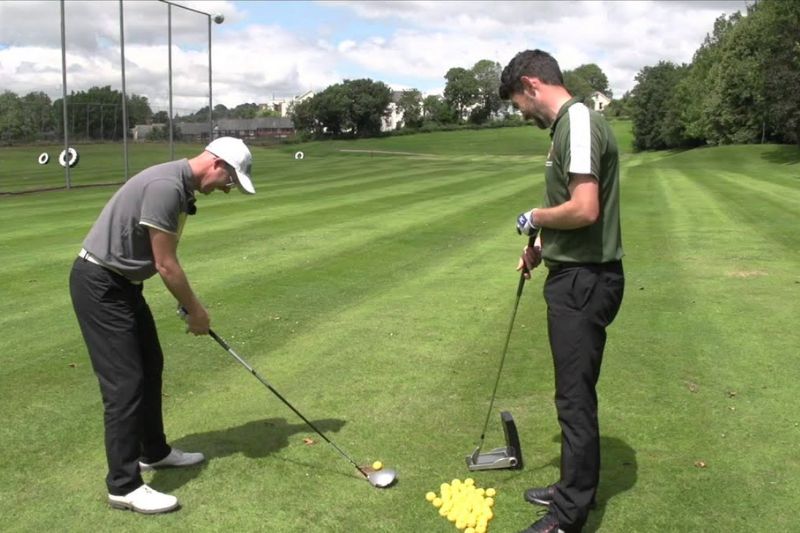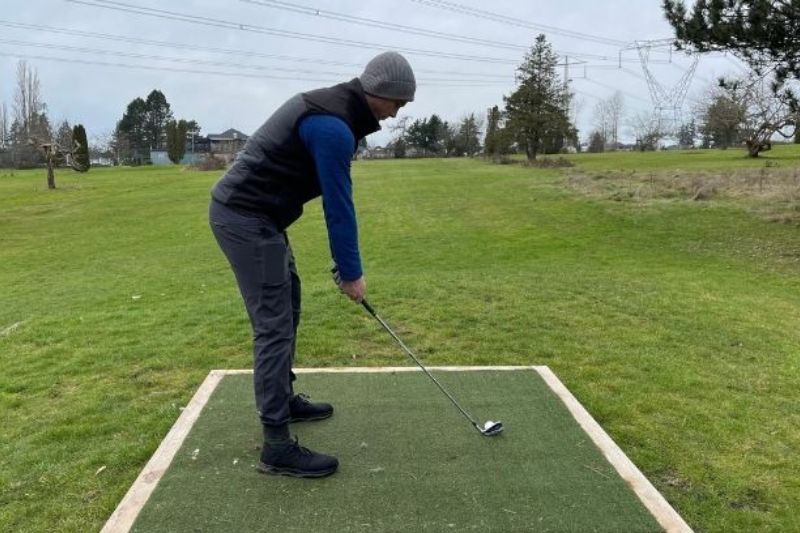Golf is a game of precision, and every little detail can make a significant difference in your performance. One of the most crucial aspects of a good golf swing is your stance, specifically how far away you stand from the golf ball. It may seem like a minor detail, but the distance between you and the ball can affect your swing path, balance, and overall consistency. In this comprehensive guide, we’ll explore everything you need to know about how far away to stand from a golf ball and other related topics. Let’s dive in!
How Far Away to Stand from Golf Ball

The distance between you and the golf ball is a fundamental aspect of your setup. This distance can vary depending on factors like your height, club length, and the type of shot you’re trying to execute. Let’s break down the key elements to consider when determining the proper distance.
Finding Your Optimal Distance
Determining the right distance from the ball is essential for achieving a consistent and effective swing. Here’s a step-by-step guide to finding your optimal distance:
Start with a Neutral Stance: Begin by standing with your feet shoulder-width apart, knees slightly bent, and weight evenly distributed. This neutral stance provides a solid foundation for your swing.
Extend Your Arms Naturally: Hold the club with a relaxed grip and extend your arms naturally. Your arms should hang freely without any tension. This position allows you to maintain control and feel comfortable throughout your swing.
Measure the Distance: To measure the correct distance, place the clubhead behind the ball and ensure it’s lying flat on the ground. The butt end of the club should be pointing towards your belt buckle or navel. This alignment helps ensure you’re neither too close nor too far from the ball.
Adjust as Needed: Depending on the club you’re using and the type of shot, you may need to adjust your distance slightly. For example, longer clubs like drivers require a slightly wider stance and a bit more distance from the ball. Conversely, shorter clubs like wedges require a narrower stance and closer proximity.
Common Mistakes in Distance Setup

Even seasoned golfers can fall into bad habits when it comes to their stance. Let’s explore some common mistakes and how to avoid them.
Standing Too Close
Standing too close to the ball can cause a cramped swing, leading to inconsistent shots. You’ll likely find it challenging to generate power and maintain balance. To avoid this, ensure you have enough space to extend your arms fully and make a comfortable swing.
Standing Too Far
Conversely, standing too far from the ball can lead to an overextension of your arms and a loss of control. This position often results in a shallow swing path and topped shots. To correct this, focus on maintaining a natural arm extension and ensure the clubhead lies flat on the ground.
Inconsistent Distance
Inconsistency in your setup can lead to unpredictable shots. Make it a habit to check your distance from the ball before each swing. A consistent setup is key to developing a reliable swing.
The Impact of Club Length
The length of your clubs plays a significant role in determining how far away you should stand from the ball. Let’s explore how different clubs affect your stance.
Drivers and Long Irons
Drivers and long irons have longer shafts, which require you to stand slightly further from the ball. This distance allows for a wider swing arc and helps generate more power. For these clubs, position the ball just inside your front heel and ensure your hands are slightly ahead of the clubhead.
Mid and Short Irons
Mid and short irons have shorter shafts, requiring you to stand closer to the ball. This setup allows for a more upright swing and better control. For these clubs, position the ball in the center of your stance and ensure your hands are in line with the clubhead.
Wedges
Wedges are the shortest clubs in your bag and require you to stand closest to the ball. This setup promotes a steeper angle of attack, ideal for precise shots around the green. For wedges, position the ball slightly back in your stance and ensure your hands are ahead of the clubhead.
The Role of Posture in Golf Setup
Your posture plays a crucial role in determining how far away you stand from the ball. Proper posture helps you maintain balance, control, and a consistent swing path. Let’s explore the key aspects of proper posture.
Neutral Spine Position
A neutral spine position is essential for a comfortable and effective swing. To achieve this, bend slightly at the hips, keeping your back straight and shoulders relaxed. Avoid hunching over or arching your back, as this can lead to tension and inconsistent swings.
Knee Flex and Balance
Slightly flex your knees to maintain a balanced and athletic stance. Your weight should be evenly distributed on the balls of your feet. This balanced position allows for a smooth weight transfer during your swing.
Chin and Head Position
Keep your chin up and eyes focused on the ball. Avoid tucking your chin into your chest, as this can restrict your shoulder turn and limit your swing. A relaxed head position promotes a full, unrestricted swing.
Factors Affecting Distance from the Ball

Several factors can influence the distance you should stand from the ball. Let’s explore some of the most important considerations.
Height and Body Type
Your height and body type play a significant role in determining your setup. Taller golfers may need to stand further from the ball to accommodate their longer arms and torso. Conversely, shorter golfers may need to stand closer to the ball to maintain control.
Swing Style
Your swing style can also affect your setup. Golfers with a more upright swing plane may need to stand closer to the ball, while those with a flatter swing plane may need to stand further away. Understanding your swing style can help you find the optimal distance.
Type of Shot
The type of shot you’re attempting can also influence your setup. For example, tee shots with a driver require a wider stance and more distance from the ball, while approach shots with irons require a narrower stance and closer proximity.
Adjusting for Different Lie Conditions
Lie conditions can vary greatly on the golf course, and adjusting your setup accordingly is crucial for making solid contact. Let’s explore how to adjust for different lies.
Uphill and Downhill Lies
Uphill and downhill lies can significantly affect your stance and distance from the ball. For uphill lies, stand closer to the ball and tilt your shoulders to match the slope. For downhill lies, stand further from the ball and adjust your shoulders accordingly.
Sidehill Lies
Sidehill lies can be challenging, as they affect your balance and swing path. For uphill sidehill lies, stand closer to the ball and lean into the slope. For downhill sidehill lies, stand further from the ball and adjust your stance to maintain balance.
Rough and Bunker Lies
Rough and bunker lies require a different approach. In the rough, stand closer to the ball and choke down on the club for better control. In bunkers, open your stance and clubface, and stand slightly further from the ball to ensure a clean strike.
The Importance of Consistency in Setup
Consistency in your setup is key to developing a reliable and effective golf swing. Let’s explore why consistency matters and how to achieve it.
Developing Muscle Memory
Consistency in your setup helps develop muscle memory, making it easier to repeat the same swing mechanics. Practice your setup regularly to create a routine that becomes second nature.
Maintaining Balance and Control
A consistent setup promotes balance and control, allowing you to make more accurate and powerful swings. Focus on maintaining the same distance from the ball and posture for each shot.
Reducing Mental Distractions
A consistent setup reduces mental distractions, allowing you to focus on executing your shot. Develop a pre-shot routine to ensure you’re always in the right position.
Frequently Asked Questions (FAQs)
1. How can I tell if I’m standing too close or too far from the ball?
If you’re standing too close, you’ll feel cramped and have difficulty generating power. If you’re standing too far, you’ll struggle with balance and control. The key is to find a comfortable distance where you can swing freely.
2. Does my height affect how far I should stand from the ball?
Yes, your height and arm length play a significant role in determining your setup. Taller golfers typically need to stand further from the ball, while shorter golfers should stand closer.
3. Should I adjust my distance for different clubs?
Yes, different clubs require different distances from the ball. Longer clubs like drivers require more distance, while shorter clubs like wedges require closer proximity.
4. How can I practice finding the right distance from the ball?
Use drills like the mirror drill and feet together drill to practice finding the right distance. Regularly check your setup and make adjustments as needed.
5. Can the wrong distance from the ball cause slices or hooks?
Yes, standing too close or too far can affect your swing path and clubface angle, leading to slices or hooks. A proper setup is crucial for straight, consistent shots.

I am the owner of Ricks Golf Shop, a popular destination for golf enthusiasts. My passion for golf began in my teenage years and has only grown over the years. With over 10 years of experience in the golf industry, I offer expert advice and quality products. With a friendly demeanor and extensive knowledge, I ensure every customer leaves happy.
